Eastney Beach
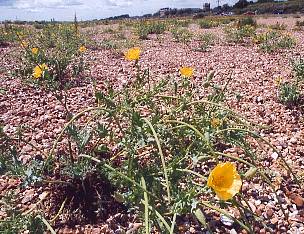 Eastney Beach is
at the south eastern end of Portsea Island, the island containing much of the
City of Portsmouth. The most significant feature of the beach is its
vegetation. Plants here have a high tolerance to salt and have adapted to
growing in shingle and sand. They range from ones which like a serious
challenge, growing on or just behind the storm ridge, to those on the more
stable but competitive grassland further inland. Seaweeds and other organic
matter from the sea help to create the soil here.
Eastney Beach is
at the south eastern end of Portsea Island, the island containing much of the
City of Portsmouth. The most significant feature of the beach is its
vegetation. Plants here have a high tolerance to salt and have adapted to
growing in shingle and sand. They range from ones which like a serious
challenge, growing on or just behind the storm ridge, to those on the more
stable but competitive grassland further inland. Seaweeds and other organic
matter from the sea help to create the soil here.
A total of 109 plant species were found by Geoff Farwell during a survey in May
1997. The level of vegetation is partly controlled by human trampling and
partly by the proximity of the sea.
Some Geomorphology
The beach consists mainly of shingle, but with many sandy patches. The shingle
is made of flint, which originally formed in layers in a huge thickness of
chalk.
A major feature on the wider parts of the beach is the storm ridge above the
high water level. This marks the highest level to which the sea and wind can
fling the shingle. Behind this ridge is a lower, more sheltered and stable
area. Were it not for modern developments, there would also be wet, marshy
ground here, as can be seen behind some parts of the beach at Stokes Bay in
Gosport.
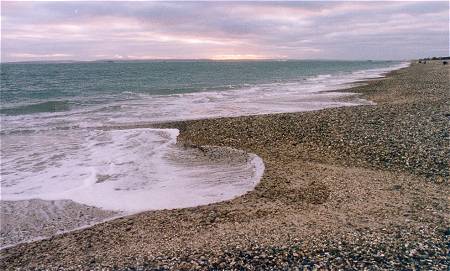 An earth bank protects the caravan park from all but the biggest storms, and
adds to the botanical interest. The concrete sea-wall around QinetiQ Fraser and
Fort Cumberland constricts the beach, so it is not possible to walk round into
Langstone Harbour if the tide is in.
An earth bank protects the caravan park from all but the biggest storms, and
adds to the botanical interest. The concrete sea-wall around QinetiQ Fraser and
Fort Cumberland constricts the beach, so it is not possible to walk round into
Langstone Harbour if the tide is in.
On the seaward side of the storm ridge are a series of steep banks called beach
berms, which are continually re-cut by high spring tides. In places there is an
attractive repeated pattern of cusps along the beach. This pattern is one
coastal feature which lacks a good scientific explanation.
Some Statistics
Vegetated shingle is recognised as a rare habitat, and some work is underway to
protect key sites. See the UK's Habitat Action Plan
(HAP) for more information. English Nature have published a report, "Maritime
State of Nature Report for England: getting onto an even keel". This says that
there are 5,130 ha of shingle habitat in the UK, with 4,350 ha in England. The
majority of this area, about 3,000 ha, is designated as 26 Sites of Special
Scientific Interest (SSSIs). 48% of these sites are said to be in unfavourable
and declining condition. There is no information on the remaining area of 1,350
ha which isn't SSSI.
16 hectares of Eastney Beach, about 1.5 km in length, are designated by
Portsmouth City Council as a Site of Importance for Nature Conservation (SINC),
from a line drawn south from the western end of Driftwood Gardens, eastwards
into the mouth of Langstone Harbour. A SINC designation carries some planning
weight but gives very little obligation for action.
A slightly smaller area stretches westwards from Driftwood Gardens and is also
of merit, with large numbers of Yellow Horned-poppy, and other plants. So in
theory, Portsmouth has about 2.4% of England's non-SSSI vegetated shingle!
Five characteristic and unusual species are highlighted here. 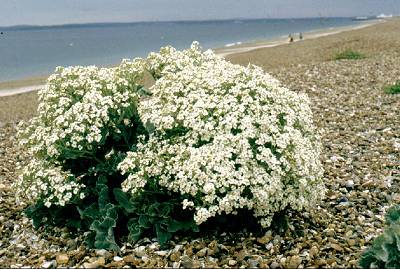
Sea Kale
This big, obvious front-line coloniser has a long thick tap root, mainly to
anchor itself against moving shingle, but also to access fresh water retained
by sand and organic matter. Its sweet-smelling flowers attract insects, and are
valuable for butterflies migrating in early summer. Sea Beet also grows in this
unstable area and elsewhere.
Yellow Horned-poppy
At the top of this page is a display of Yellow Horned-poppy, a little way east
of the Royal Marines Museum, but not within the SINC. The plant takes its name
from the long seed pods. Many of the common beach plants, such as Sea Kale and
Sea Beet, are edible, but the poppy is poisonous.
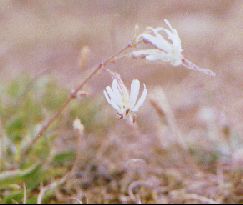
Nottingham Catchfly
This nationally scarce plant, pictured left, can be found on the more stable
parts of the beach in front of the caravan park, forming low-growing patches.
This plant used to be frequent on the roadside down to the Hayling Ferry,
displaying much taller growth. There is also some on the north side of the bank
in front of the caravan park, but it gets cut too early.
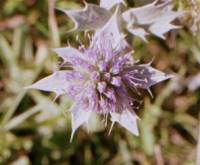
Sea Holly
One of the last plants to flower here during the summer is Sea Holly, pictured right, but sadly
this can now be counted on only one hand on the parts of the beach accessible
to the public. Its stronghold is behind the razor wire around QinetiQ Fraser, but this site is likely to be re-developed with luxury flats, so its future is pretty bleak.
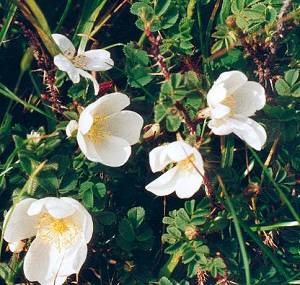
Burnet Rose
Rare in Hampshire, favouring the coast and parts of the New Forest. There is a
small low-growing patch on a line south of the swimming baths, and some more on the bank
near its eastern end. It is not difficult to spot when in flower in May or early June.
Other plants
Other low-growing plants are Sea Sandwort, Sand Sedge and various clovers. One plant which has become extinct at Eastney in recent times is the Childing Pink. This was rediscovered at Hayling Island in 1998, so there is always a possibility of its return.
Bird life
The beach is valuable for bird life. Ringed Plover may breed successfully where
they are not disturbed. Gulls and wading birds such as Dunlin and Sanderling
may use the relatively sheltered ares behind the storm ridge to roost during
high tides in winter, when the mud-flats in the harbours are covered by the
sea.
Behind the fence
The eastern end of the beach is backed by a wire-mesh fence belonging to Qinetiq Fraser, and housing various radar and experimental installations. Shingle in front of the buildings has an impressive display of Sea Holly, probably the only viable population on Portsea Island. Redevelopment of Fraser, in the form of three residental blocks housing 131 apartments, would almost certainly be the end of this plant. The attractive purple flowers of Sheep's-bit can also be seen through the fence.
Naturists have been using the beach in front of the fence for maybe 50 years, and are unhappy at the proposed development. Their fear is that objections from the residents may lead to a ban on nude swimming and sun-bathing. For more details, see the Eastney Naturists web site.
Round the Bend
Going further east (at low tide) past the concrete at the harbour entrance, there is more shingle to explore, with some scrub. The uncommon Grey Bush Cricket may be found here.
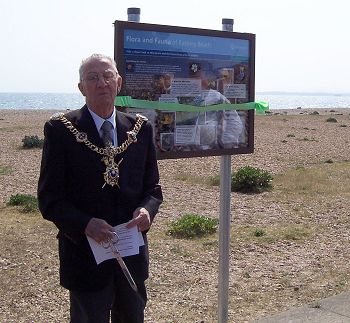
Interpretation
Truly natural habitats are hard to come by, but this shingle beach is a close
runner. Less trampling would allow more vegetation, probably including some
ground-dwelling lichens. A threat could be the dreaded Japanese Knotweed, which
is growing in a patch to the west. This would be one of the few places where
any sort of cutting or extra disturbance is justified. Sometimes there are
complaints about “weeds on the beach” from a few members of the
public, who would presumably prefer bare shingle over all of the beach.
To help redress the balance, the City Council have recently installed two interpretation signs, one at the end of St. Georges Road, and one further east at the end of the promenade.
Friends of Eastney Beach?
It is hoped to establish a group of local people who are interested in the future of the beach. The current plan is that such a group would initially be assisted by Eastney Neighbourhood Forum.
Looking East
West Sussex has significant stretches of vegetated shingle. This has been the
subject of recent work to increase public awareness. See the West Sussex Vegetated Shingle Project.
Back to Sites
 Eastney Beach is
at the south eastern end of Portsea Island, the island containing much of the
City of Portsmouth. The most significant feature of the beach is its
vegetation. Plants here have a high tolerance to salt and have adapted to
growing in shingle and sand. They range from ones which like a serious
challenge, growing on or just behind the storm ridge, to those on the more
stable but competitive grassland further inland. Seaweeds and other organic
matter from the sea help to create the soil here.
Eastney Beach is
at the south eastern end of Portsea Island, the island containing much of the
City of Portsmouth. The most significant feature of the beach is its
vegetation. Plants here have a high tolerance to salt and have adapted to
growing in shingle and sand. They range from ones which like a serious
challenge, growing on or just behind the storm ridge, to those on the more
stable but competitive grassland further inland. Seaweeds and other organic
matter from the sea help to create the soil here. An earth bank protects the caravan park from all but the biggest storms, and
adds to the botanical interest. The concrete sea-wall around QinetiQ Fraser and
Fort Cumberland constricts the beach, so it is not possible to walk round into
Langstone Harbour if the tide is in.
An earth bank protects the caravan park from all but the biggest storms, and
adds to the botanical interest. The concrete sea-wall around QinetiQ Fraser and
Fort Cumberland constricts the beach, so it is not possible to walk round into
Langstone Harbour if the tide is in.



